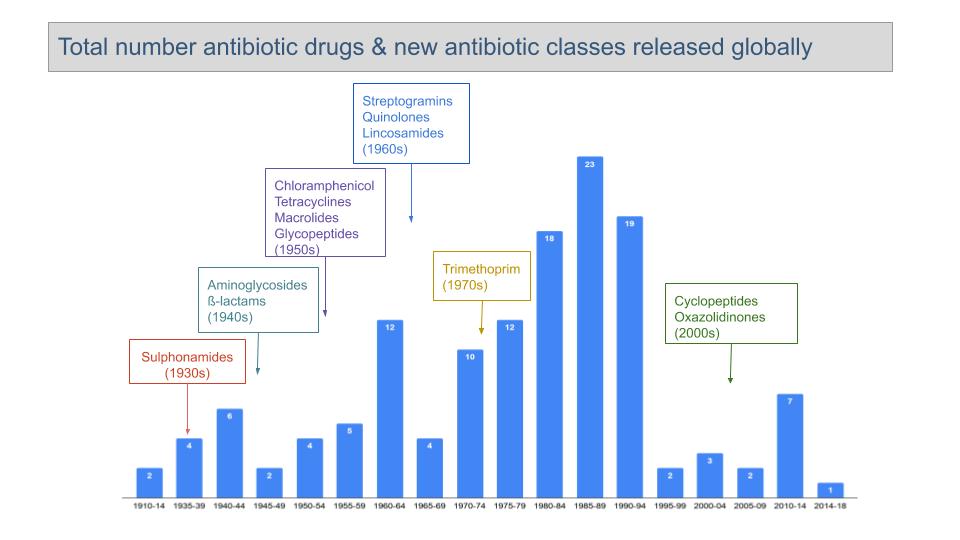
While COVID19 is grabbing world attention, another global public health threat is still rising in the wings - #AMR. By 2050 AMR could cause 10 million deaths if left unchecked. AMR is not new and its history stretches back long before penicillin. whatisbiotechnology.org/index.php/exhi… /1 

The first case of drug resistance was noted in 1907 by #PaulEhrlich, when he observed mice infected with Trypanosoma brucei developed resistance with repeated doses of #Salvarsan, the first compound found to have antimicrobial activity. whatisbiotechnology.org/index.php/exhi… /2 

Another drug spotted to cause resistance was Optochin, an antimicrobial agent used to treat pneumonia. The first instance of resistance was noted in mice, infected with pneumococcal bacteria, in 1910, and then in humans in 1913. /3 

Resistance also developed fast with sulphonamides, antimicrobial drugs administered on a huge scale from the mid-1930s to treat infections caused by streptococci, including puerperal fever which was a major cause of childbirth deaths. /4 

#Sulphonamides were quickly adopted by the military to treat war wounds and gonorrhea. First used by both sides in the Spanish Civil War, sulphonamides were a regular part of army supplies in WW2. /5 

The popularity of sulphonamides was boosted by their use to successfully treat pneumonia in Winston Churchill in 1944 and a severe throat infection in Franklin Roosevelt, the US president’s 22 year old son. whatisbiotechnology.org/index.php/exhi… /6 

Albert Alexander, the first patient treated with purified penicillin, died of AMR in 1941 because he was unable to take the full course of treatment due to the drug supply drying up. whatisbiotechnology.org/index.php/exhi… /9 

One of the first people to voice concern about #AMR
was Fleming who in 1936 warned medical students about the overuse of penicillin and then again highlighted the issue when receiving his #NobelPrize in 1945. whatisbiotechnology.org/index.php/exhi… /10
was Fleming who in 1936 warned medical students about the overuse of penicillin and then again highlighted the issue when receiving his #NobelPrize in 1945. whatisbiotechnology.org/index.php/exhi… /10

René Dubos was another key figure to warn of the dangers of the overuse of antibiotics. The first to develop a systematic approach to discover new antimicrobial agents, Dubos issued his first warning in 1942, arguing bacteria would always fight back. whatisbiotechnology.org/index.php/exhi… /11 

Initial concerns about AMR were allayed by the belief that scientists could always develop new drugs to counter the problem. /12
Concerns about AMR became more pessimistic from the 1950s following the discovery of plasmids, small circular DNA pieces found in the environment, could transfer resistance between different bacterial species
whatisbiotechnology.org/index.php/exhi… /13
whatisbiotechnology.org/index.php/exhi… /13

How microbes develop resistance to drugs was a question that puzzled scientists from the early 20th century. Initially scientists like #CyrilHinshelwood thought bacteria were simple organisms that acquired new traits through training or adaptation.
whatisbiotechnology.org/index.php/exhi… /14
whatisbiotechnology.org/index.php/exhi… /14

By the late 1940s a number of discoveries had been made about bacteria and the inheritance process, including by Max Delbrück and Salvador Luria, which undermined the adaptation model. 15/ 

Different forms of genetic exchange behind AMR were unravelled as a result of the work of Esther and Joshua Lederberg from the late 1940s.
whatisbiotechnology.org/index.php/exhi… /16
whatisbiotechnology.org/index.php/exhi… /16

Unravelling the biological mechanism behind AMR was helped immeasurably by Esther Lederberg’s replica plating method for transferring bacteria colonies between petri dishes. Esther's strong knowledge of fabrics helped her to develop the technique /17
whatisbiotechnology.org/index.php/exhi… /
whatisbiotechnology.org/index.php/exhi… /

Although a major pioneer of bacterial genetics and understanding AMR, Esther Lederberg has largely been overshadowed by her husband Joshua who won the #NobelPrize in 1958. /18 

Esther Lederberg is only one of the many women whose important role in the AMR story is largely hidden. Another is Agelina Fanny Hesse who pioneered the use of agar to grow bacteria based on her jam-making knowledge. whatisbiotechnology.org/index.php/exhi… /19 

An equally important woman in the story of AMR is Mary Barber who on noticing the rise of penicillin resistant infections at Hammersmith hospital in the late 1940s devised the first preventative strategy to prevent AMR transmission in hospitals.
whatisbiotechnology.org/index.php/exhi… /20
whatisbiotechnology.org/index.php/exhi… /20

#NaomiDatta is another woman forgotten in AMR history. She played a pivotal role in confirming the importance of plasmid-mediated resistance which she discovered while investigating a severe outbreak of Salmonella typhi at Hammersmith Hospital whatisbiotechnology.org/index.php/exhi… /21 

All too often the story of AMR traditionally begins with Flemming’s discovery of #penicillin. Yet many before him noticed the therapeutic potential of the Penicillium fungus
whatisbiotechnology.org/index.php/exhi… /22
whatisbiotechnology.org/index.php/exhi… /22

One of the first medics to treat a patient with an extract from the Penicillium fungus was the famous surgeon Joseph Lister, who in 1884 used it to cure a patient’s abscess whatisbiotechnology.org/index.php/exhi… /23 

Another person to notice the therapeutic properties of a mould was Vincenzo Tiberio, who, while training as a physician in Naples was struck by how many people suffered from intestinal disorders whenever they drank water from a well when its walls were cleaned from mould. /24 

Many different classes of antibiotics have been developed since penicillin, but resistance has always followed the generation of new antibiotics. /25 

The full significance of AMR always occurring with new drugs was not grasped until the 1970s when it became clear that a number of bacterial strains had become resistant to multiple antibiotics. Multi-drug resistance in S.aureus (MRSA) is now the norm. whatisbiotechnology.org/index.php/exhi… /26 

A key tool needed to curb the rising threat of AMR is rapid and affordable #diagnostics which can help determine if patients have bacterial or viral infections at the point of care and so increase more efficient use of antibiotics.
whatisbiotechnology.org/index.php/exhi… /29
whatisbiotechnology.org/index.php/exhi… /29
@threadreaderapp unroll
• • •
Missing some Tweet in this thread? You can try to
force a refresh






